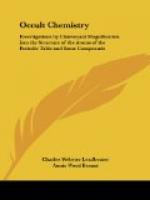BROMINE (Plate V, 3).
Three additional bodies appear at the top of the funnel, which otherwise repeats that of chlorine. The connecting rod is the same and may be disregarded. The central globes become more complex. The additions are, however, of very easy types, and hence are readily dealt with. Each of the three similar ovoid bodies contains two triplets—each a triangle and a quintet—a four-sided pyramid. These are the same, as may be seen in the connecting rod of chlorine, and we need not repeat them. Only the globe remains. This does not break up as a proto-compound but is merely set free, a and the 2 bs whirling in a plane vertical to the paper and the two smaller bodies, cc, whirling on a plane at right angles to the other. These two disengage themselves, forming a quartet as a meta-compound, while a makes a whirling cross and bb a single sextet; these further dissociate themselves into four pairs and two triplets.
IODINE (Plate V, 4).
[Illustration]
Iodine has nothing new to give us, except five similar ovoid bodies at the top of each funnel, and two quartets instead of two pairs in the central globe. The ovoid bodies become spheres when the funnels are thrown off, and a crystalline form is indicated within the sphere. The atoms are arranged in two tetrahedra with a common apex, and the relationship is maintained in the meta-body, a septet. The latter breaks up into two triplets and a unit on the hyper-level. In the central globes, the a of bromine is repeated twice instead of the pairs in cc.
COPPER (Plate VI, 3).
We have already disposed of occultum, on this plate, and of sodium, which lies at the root of both groups. Copper, we now find, is also very largely off our hands, as the funnel provides us with only two new types—two spheres—each containing five atoms in a new arrangement, and the triangular body at the mouth with its ten atoms. This triangular body, with an increased number of atoms, reappears in various other chemical elements. The central globes are different from any we have had before, in their internal arrangement, but the constituents are familiar; there are two contained spheres with four atoms each, the a in the globe of bromine (see above) and 2 “cigars.” The “cigars” may be followed under occultum (see above). The connecting rod is as in chlorine, bromine and iodine.
The atoms in the bodies a and b are curiously arranged. A consists of two square-based pyramids turned so as to meet at their apices, and breaks up into two quartet rings and a duad. B is again two four-sided pyramids, but the bases are in contact and set at right angles to each other; the second apex is not seen, as it is directly below the first. The pyramids separate as meta-bodies, and the atoms assume the peculiar arrangement indicated and then break up into four pairs and two units on the hyper level.




